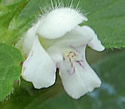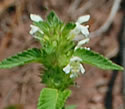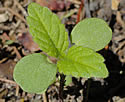Galeopsis tetrahit (Brittlestem Hemp-nettle)
| Also known as: | Common Hemp-nettle |
|---|---|
| Genus: | Galeopsis |
| Family: | Lamiaceae (Mint) |
| Life cycle: | annual |
| Origin: | Europe, Asia |
| Status: |
|
| Habitat: | part shade, shade; woods, roadsides, waste areas |
| Bloom season: | June - September |
| Plant height: | 1 to 3 feet |
| Wetland Indicator Status: | GP: FACU MW: FACU NCNE: FACU |
| MN county distribution (click map to enlarge): |  |
| National distribution (click map to enlarge): |  |
Pick an image for a larger view. See the glossary for icon descriptions.
Detailed Information
Flower: 


![[photo of flowers]](/udata/r9ndp23q/purple/hemp-nettle_0720_105455-t.jpg) Flowers are in whorls of 2 to 6 at the top of the plant and at leaf axils in the upper part of the plant. Individual flowers average about ¾ inch long, are irregularly tubular with a broad upper lip and a 3-parted lower lip with the middle lobe the largest. The outside of the upper lip is covered in long white hairs. The inside of the lower lip is striped with purple and usually has 2 bumps and 2 white or pale to bright yellow spots near the throat. There are 4 stamens that arc along the inside of the upper lip. Flower color ranges from pink to purple and is sometimes white. Plants are often branched with flowers on each branch.
Flowers are in whorls of 2 to 6 at the top of the plant and at leaf axils in the upper part of the plant. Individual flowers average about ¾ inch long, are irregularly tubular with a broad upper lip and a 3-parted lower lip with the middle lobe the largest. The outside of the upper lip is covered in long white hairs. The inside of the lower lip is striped with purple and usually has 2 bumps and 2 white or pale to bright yellow spots near the throat. There are 4 stamens that arc along the inside of the upper lip. Flower color ranges from pink to purple and is sometimes white. Plants are often branched with flowers on each branch.
Leaves and stem: 

![[photo of leaves]](/udata/r9ndp23q/purple/hemp-nettle-100_0563-t.jpg) Leaves are up to 2½ inches long and 1½ inch wide, hairy, roughly egg-shaped, pointed at the tip, rounded or wedge-shaped at the base, with serrated edges and hairy stalks. Attachment is opposite, with each pair at right angles to the pair below it.
Leaves are up to 2½ inches long and 1½ inch wide, hairy, roughly egg-shaped, pointed at the tip, rounded or wedge-shaped at the base, with serrated edges and hairy stalks. Attachment is opposite, with each pair at right angles to the pair below it.
![[photo of stems]](/udata/r9ndp23q/pd/galeopsis-tetrahit-8-t.jpg) Stems are square, bristly hairy, swollen below the leaf nodes, and typically many-branched.
Stems are square, bristly hairy, swollen below the leaf nodes, and typically many-branched.
Fruit: 
The flower heads dry to dark brown as fruit matures. A flower produces 4 nutlets, each containing a single seed.
Notes:
This is becoming a serious pest along the North Shore of Lake Superior, as well as in other parts of Minnesota, and is likely much more widespread than the distribution map indicates. A single plant generates hundreds of seeds, which stay viable for several years. The seeds drop near the mother plant and masses of seedlings can pop up the following spring. I had a bad infestation in my own yard for some years but after diligent hand pulling and increasing native plant diversity it has dwindled down to almost nothing. There are 2 varieties recognized in Minnesota, though the trend is to treat them as separate species: var. bifida, the more common in the state and also known as Galeopsis bifida, and var. tetrahit. The descriptions in different references conflict, but according to Flora of North America (actually Flora of China), G. bifida has mostly white flowers, rarely pink. Other references say G. bifida has mostly pink flowers with a notch in the lower lip. The vast majority of plants in Minnesota have pink flowers, but the notching they refer to is unclear and not obvious in our own images. We'll wait for the Bell Herbarium and DNR to decide what we really have here.
Native Plant Nurseries, Restoration and Landscaping Services ↓
More photos
 Brittlestem Hemp-nettle plants
Brittlestem Hemp-nettle plants Brittlestem Hemp-nettle plants
Brittlestem Hemp-nettle plants Brittlestem Hemp-nettle plants
Brittlestem Hemp-nettle plants white flowers
white flowers a plant with white flowers
a plant with white flowers a mass of Brittlestem Hemp-nettle seedlings
a mass of Brittlestem Hemp-nettle seedlings
Photos by K. Chayka taken in Lake and Ramsey counties. Other photos courtesy Peter M. Dziuk.
Comments
Have you seen this plant in Minnesota, or have any other comments about it?
on: 2010-02-18 10:11:14
All over my driveway. send Peter up in the late summer he can stomp it out with his bare feet. its on the outhouse path to so you do need slippers. eradication by blow torch works well so no herbicide.
on: 2010-02-18 11:33:41
Torching it sounds like a good method of control to me. :-)
on: 2011-08-09 07:59:28
The patch I've photographed fits the description to a T except that the flowers are slightly smaller..... 1/8 - 1/4 inch. Is the flower size related to soil, light, ??
on: 2012-11-25 18:16:26
I have these in our fields on the Sustainable Agriculture Project's Farm at the UMD Farm... ca. 4 miles north of Duluth... prickly and poisonous, right?
on: 2014-08-16 21:05:53
These have sprung up in every new garden bed we made earlier this year. Various site conditions, on top of sheet mulched beds and Hugelkultur beds. We were wondering what they were, now we just need to find a use for them.
on: 2015-08-06 13:05:08
Found in a wetland with dogwood and willows at the road's edge (SE 54th Ave).
on: 2017-06-26 14:10:37
Shows up on paths and logging roads, disturbed soils in clear-cuts. I have seen an insect, the white-margined burrower bug, eat the seeds of this plant.
on: 2018-05-30 11:11:38
these things have popped up all over my garden. i've been pulling them out every single day, at first i thought they were some kind of clover but some of them i didn't see right away and have grown up a bit and then i thought they might be mint, but they don't smell minty....someone in a plant identification group sent me to this page. yup. that looks like what i'm dealing with. are they posionus? will they affect the rest of my garden? i have children and dogs should i be worried about this plant? how can i kill these things off with out harming my garden?
on: 2018-05-30 19:49:08
Sonja, this weed came up in my own garden and persistent hand pulling got rid of them for the most part. Keep in mind you'll have a seed bank to contend with so it may take a few years before you see a big reduction. Also, if any other populations are nearby (parks, neighbors, etc.) it would behoove you to encourage others to eradicate them as well, which will help keep them out of your own yard.
on: 2019-08-12 00:24:57
These came up in my garden this spring when I've taken variety mints from the other garden. At first I thought they were some kind of mints but after, I found that they don't smell minty. Last week, they've bloomed some purple flowers. Because their flowers are beautiful, so I'm wondering that I have to kill them or let them stay in my garden?
on: 2019-08-12 07:05:59
Michelle, this is an invasive species and can overtake your garden in a few years. I had some in my own garden over 10 years ago and am still pulling up seedlings every year.
on: 2019-08-12 21:28:12
Thank you Chayka. I'm still confused because I'm not sure if my own is hemp nettle or not? Its stem is purple and hairless. Flowers have small branches separated from the trunk. Can I sent the picture to you see throught?
on: 2019-08-13 08:07:01
Michelle, your description doesn't sound like hemp nettle. Post your images on the Minnesota Wildflowers Facebook page so that others can learn from it, too.
on: 2020-07-25 23:07:43
I have found this in 3 different locations around Gull Lake in the past week. Pink.
on: 2020-08-04 09:12:05
Commented above. Im finding large masses of this everywhere. People's yards, shorelines, next to Pillsbury forest, along Trail 77 Lake Shore.
on: 2020-10-25 08:12:10
Found Galeopsis tetrahit (Brittlestem Hemp-nettle) widespread in Lebanon Hills Regional Park 09/2020. Is this but another species facilitated by the current afforested state in our historic savanna ecosystems, driven by excess nitrogen, excess shade, etc.?
on: 2021-08-19 17:14:01
Newer invasive spp in Minnetonka Parks. Found 4-foot dia patch overtaking Scutellaria. Will be removed tomorrow. Regrettably, seeds have dropped, so there will be more.






